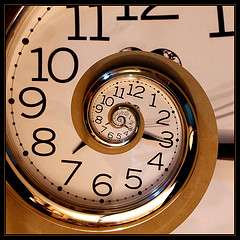Remember, Time is a greedy player who wins without cheating, every round! It’s the law. — The Clock – Charles Baudelaire
 One of the biggest challenges small businesses face is time – there’s never enough to get it all done.
One of the biggest challenges small businesses face is time – there’s never enough to get it all done.
In fact, I often advise businesses to create and promote features that save time and make use more convenient over any other when marketing to small businesses.
As a business owner one of the things that robs you of your time is lack of focus. It is so easy to get distracted by the thing that is calling the loudest, no matter if it’s the thing you really need to do today.
If throughout the day you have a finite amount of time and an infinite list of things on your plate, then it’s crucial that you develop a habit of focusing on the most important things on that list on a consistent basis.
Here are my tips for staying focused and getting the right things done.
Refer to your list
I keep a list of high payoff activities at my ready so that when I’m faced with a choice of doing one thing over another, procrastinating or making busy work, I can refer to it and know that if I choose to focus on an action on that list, I’ll be doing what needs to be done.
For example, client work is big and so is writing a blog post, replying to some email or responding to a coworker’s request may not be.
You can even make a scoring system of high payoff activities, like marketing related actions, and aim to score so many points in a day.
Make focus a game
Multi-tasking may be seen as highly developed skill, but I’ve learned it will rob you of any focus and pretty much turn you into a passive aggressive bundle of stress. (Maybe I’m projecting a bit here, but that’s my take)
Once you start to practice single minded focus you’ll realize what a gift it is, but you need structure to do it effectively. There are some great theories on how to do this, including one called the Pomodoro Technique, but the basic concept is to get yourself a timer (I use Apimac timer on a Mac) and do laser focused work on one thing only for a set time period and then come up for air. I take five by doing something physical or playing a few licks on the guitar and then I dive in again on one thing.
I find that this game like approach allows me to get much more done and keeps me from straying off down the email distress alert rabbit hole.
Develop no compromise routines
Once you’ve developed your list of high payoff activities there are some routines you probably should adhere to in order to make sure you get certain high payoff activities done before you do anything else.
For instance, I’ve determined writing a blog post every morning is an important activity, so I pledge to do it before I check email in the morning and I find that I get it done more easily and don’t get distracted by that one negative email among the hundreds I got over night.
Get what you resist off the list
I’ve found making a list of action steps for the day and checking each off as I complete them is a great way to keep a daily plan and motivate me to complete the list. I’ve also found that some days that list has a few things I don’t really like to do (usually around accounting.) Since I don’t like to do them, I find it easier to leave them to last, but then they hang there all day like a big ball and chain.
Get the thing you like to do least done first and you’ll free up the creative energy to focus on the rest of the list.
Chunk big projects
Sometimes big projects, ones that require large inputs of time, can be hard to get started because they feel overwhelming.
Using the timing game listed above I’ll often dedicate some blocks of focus to a big project every day for a week and then find that by spending a little time each day, I’ve reduced the project to one final push. The key here is to keep a list of these big projects, break the list into some action steps, and then review it each day and add some steps to you daily plan.
Insulate yourself
If you work in an organization with more than one staff member you know that a big time robber is interruptions from other folks. Some interruptions can be important, but many are not. If you use the timing focus technique start training people that you can answer their questions, in person or by IM, during one of your breaks.
Alternatively, you might schedule blocks of time to meet with your team or collaborators for set periods to consistently cover action steps. The main thing here is to eliminate or minimize the unstructured focus breakers and sometimes that takes training, door locks, and in or out signs. You can also turn off IM, turn off email, and silence the phone.
Image credit: Robbert van der Steeg

